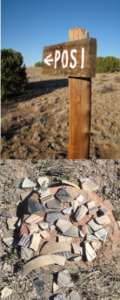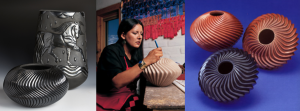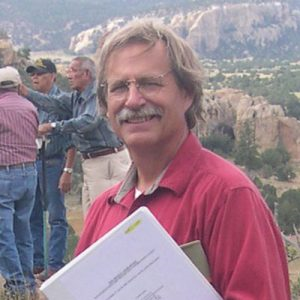660 Garcia Street
Santa Fe
NM
Exploring the Tewa World: Posi-Ouinge and The Youngblood Family of Santa Clara Pueblo

Sign and Pot Sherds at Posi-Oiunge
May 4, 2019
Cost per person:
$270 (Includes a $25 tax-deductible donation to SAR)
To register for this trip click here.
Study Leader: Porter Swentzell and Kurt Anschuetz
The Tewa people have lived in northern New Mexico for centuries, including the modern villages of Santa Clara, Okhay Owingeh, San Ildefonso, Tesuque, Pojoaque, and Nambe Pueblos. The ancestral villages of the Tewa are scattered along the tributaries of the Rio Chama and Rio Grande, including the archaeological site called “Posi-Ouinge” located near Ojo Caliente.
The story of Posi-Ouinge is a central part of the Tewa people’s history of their origin. The Summer People and the Winter People were at one-time divided as they traveled down the Rio Grande and Rio Chama toward the Española Valley, which is the heart of the Tewa’s traditional homeland. Each group built a series of villages as they made their journey. Eventually, the Tewas united to become a single community, and they lived together at one village, a place they call Posi-Ouinge “the greenness pueblo” above the Ojo Caliente hot springs. Leaving—but never forgetting—Posi-Ouinge as a place of residence, mixed groups of Summer and Winter People resumed their ancestor’s journey downstream to found the Tewa Pueblos that we know today.
Posi was a thriving center of Tewa village life from the late 1300’s until early 1500’s, just before the arrival of the Spanish. Inhabited by generations of people for over a century, this large adobe village may have had as many as 1,000 ground floor rooms and almost as many on the second and third stories.
Today, Santa Clara Pueblo is one of six Tewa-speaking Pueblos in New Mexico and is the home of many notable potters including Nancy Youngblood. We will have the honor of meeting with and hearing from Nancy who is from a long line of remarkable potters including Sara Fina Tafoya and Margaret Tafoya. Known for her highly polished and precise ribbed and swirled pottery, Nancy won Best of Show at SWAIA Indian Market in 1989 and Best of Class in Pottery in SWAIA’s 2015 and 2018 markets.
During our visit, not only will we have the opportunity to witness an outdoor firing and enjoy a traditional Pueblo meal at Santa Clara Pueblo, we also will meet some of Nancy’s illustrious family. Finally we will learn about their ancestors who helped put Santa Clara blackware pottery on the map, the Tafoya’s of Santa Clara Pueblo. SAR is privileged to hold six pots by great-grandmother Sara Fina Tafoya, four by grandmother Margaret Tafoya, and one by mother Mela Youngblood in the Indian Arts Research Center collections.

Coiled pottery by Nancy Youngblood and Nancy Youngblood at work with coiled pot. Photo courtesy of Nancy Youngblood
Porter Swentzell and Kurt Anschuetz will be our guides into the ancestral Tewa world of Posi and the contemporary Tewa community of Santa Clara Pueblo or“Kha’p’o Owingeh”, translated as the “Valley of the Wild Roses.” Porter Swentzell is from a family of artisans, farmers, and scholars at Santa Clara Pueblo. He was the first person to receive a Bachelors of Arts in Pueblo Indian Studies at Northern New Mexico College, received his PhD in Philosophy at Arizona State University, and is currently Assistant Professor and Chair of Indigenous Liberal Studies, at the Institute of American Indian Arts.

Kurt F. Anschuetz
Kurt F. Anschuetz, received his MA at the University of New Mexico and his PhD at the University of Michigan. He is an anthropologist and archaeologist, who is engaged in long-term projects documenting the history of occupation by Pueblo peoples and their agricultural water management in the Tewa Basin, including the vicinity of Posi-Ouinge. He also provides technical assistance to the Pueblo of Acoma in its efforts to protect its traditional cultural relationships with Mount Taylor.
Activity Level: Moderate, involves climbing a steep, slick-rock escarpment and walking on an uneven dirt trail to reach Posi-Ouinge’s great mounds of melted adobe. Round trip, the hike will cover approximately one mile. Lunch will be a traditional meal at the Santa Clara Pueblo followed by artist demonstration.
Includes: Transportation in air-conditioned mini coach; traditional pueblo meal at Santa Clara Pueblo; and pottery demonstration by Santa Clara potter
Field trips are open to SAR members and our Galisteo members and up receive priority registration. For more information about SAR’s field trips, including activity levels and our cancellation policy, please visit our field trips page here.